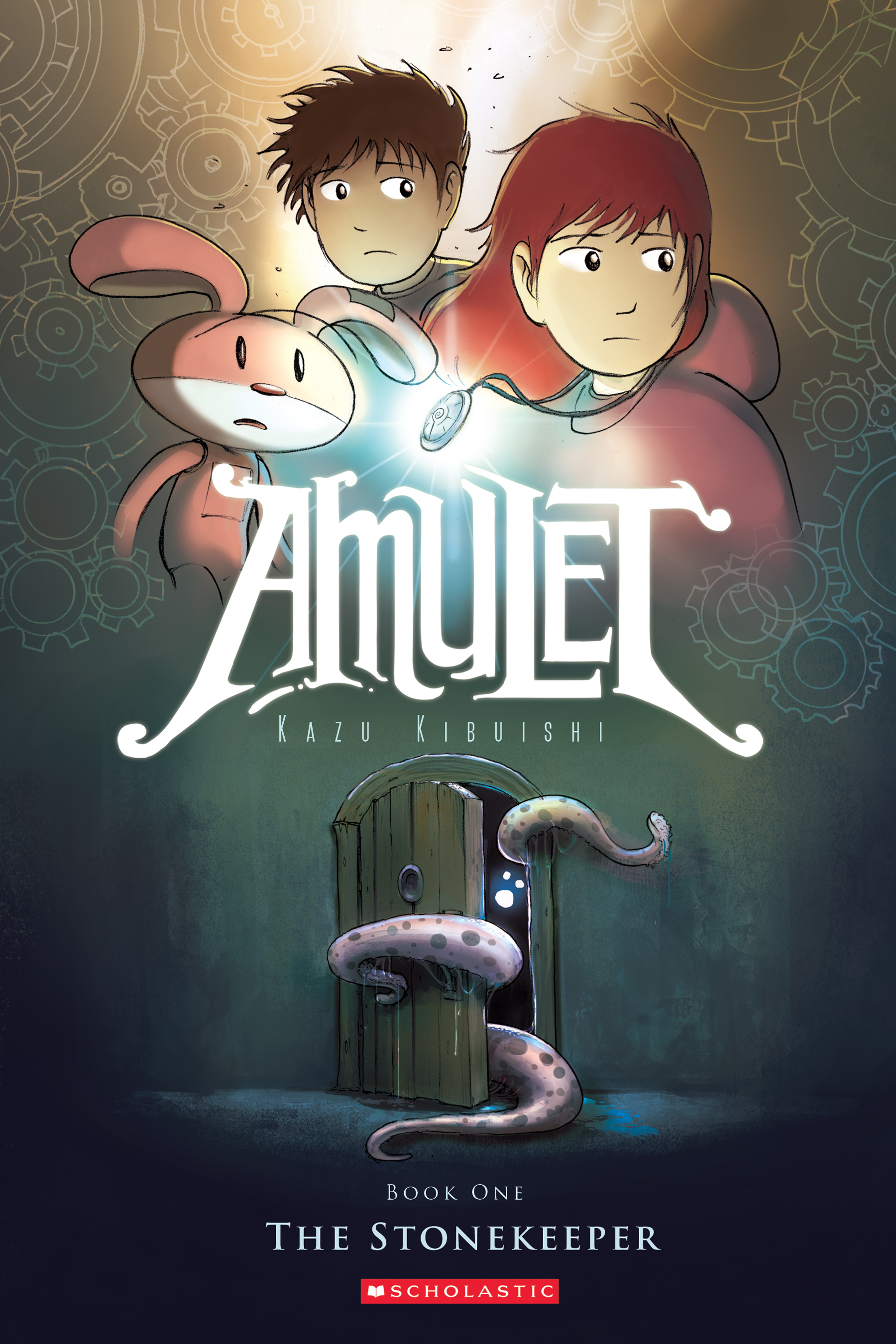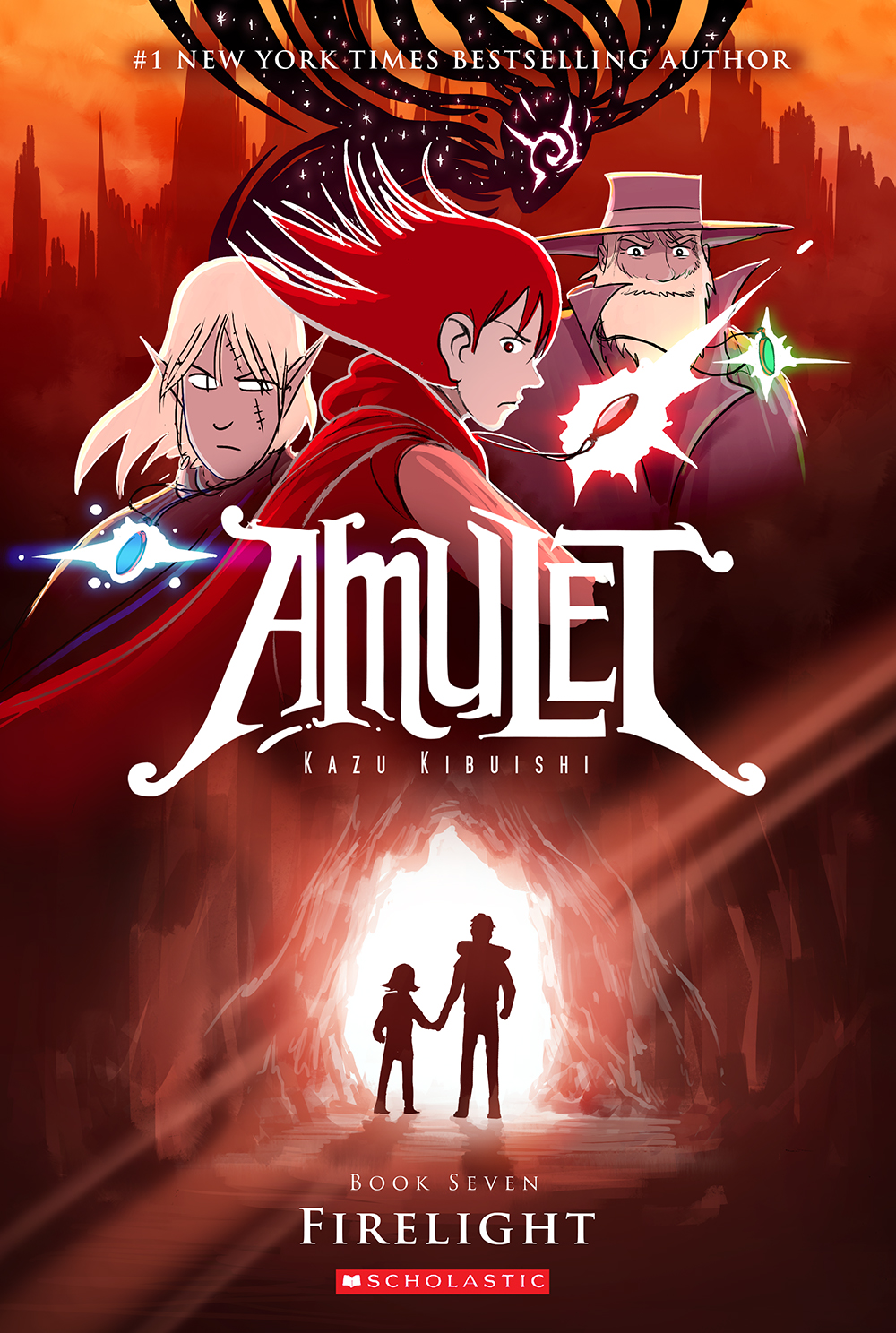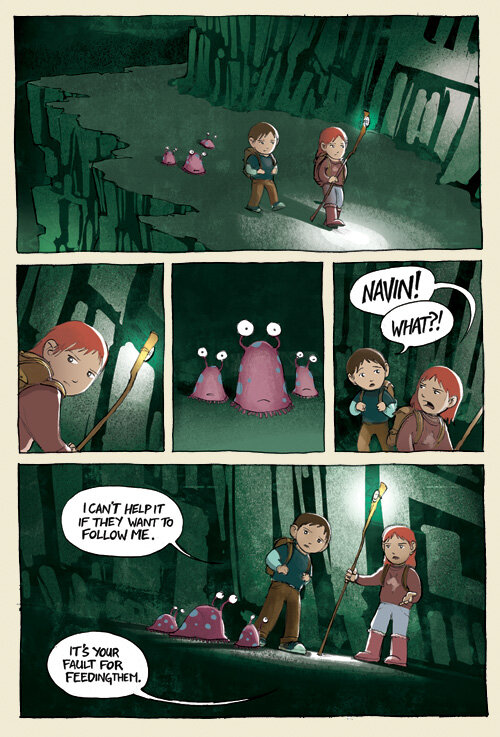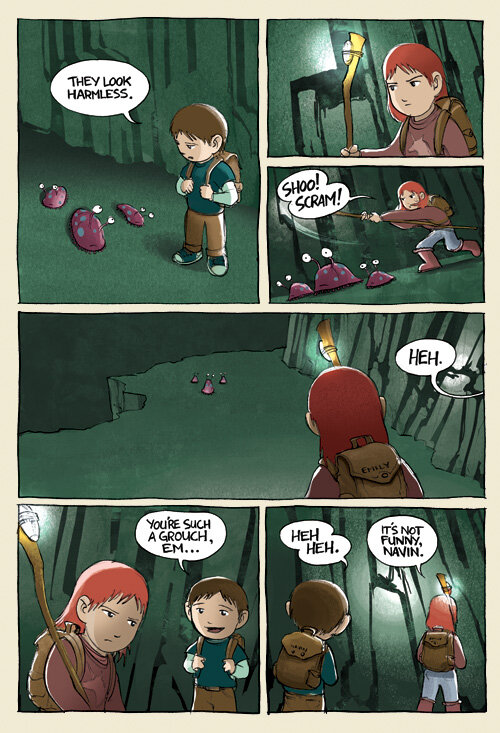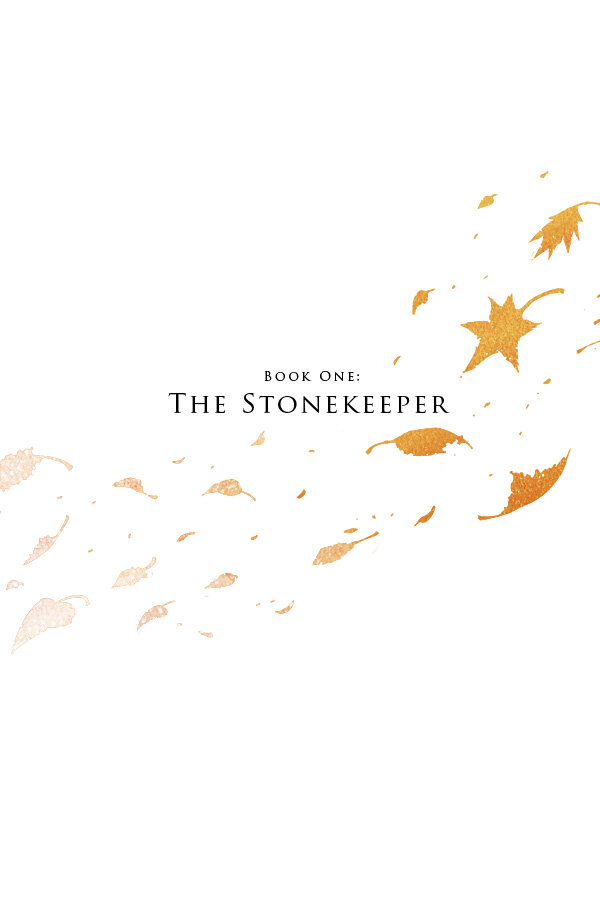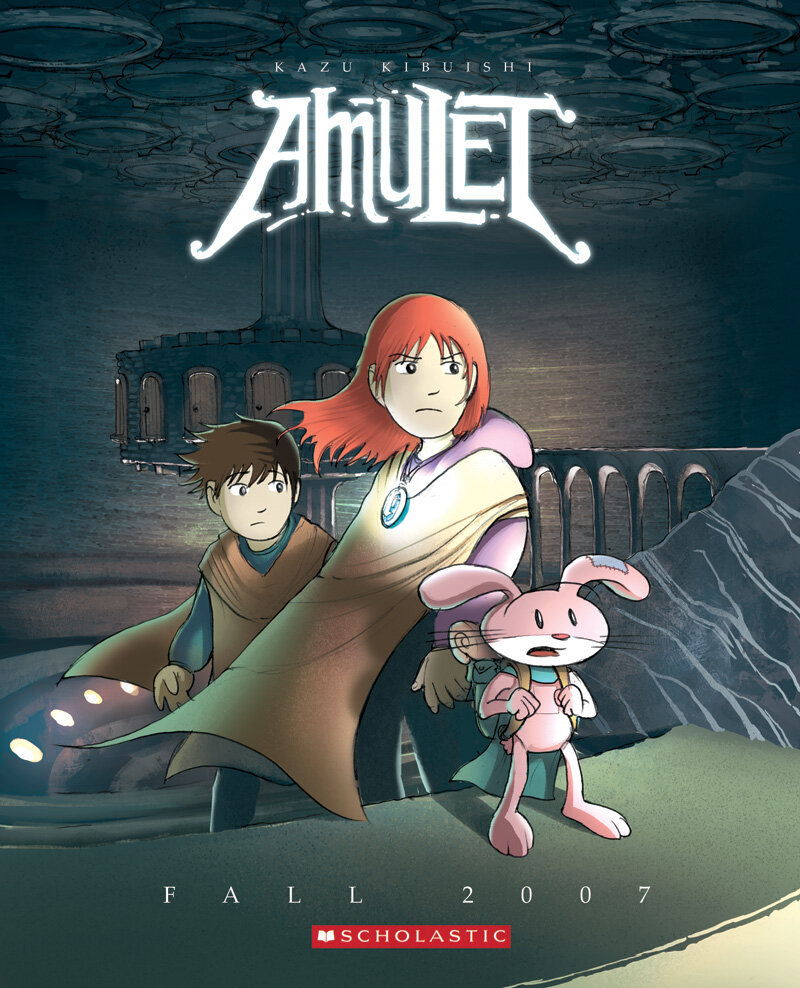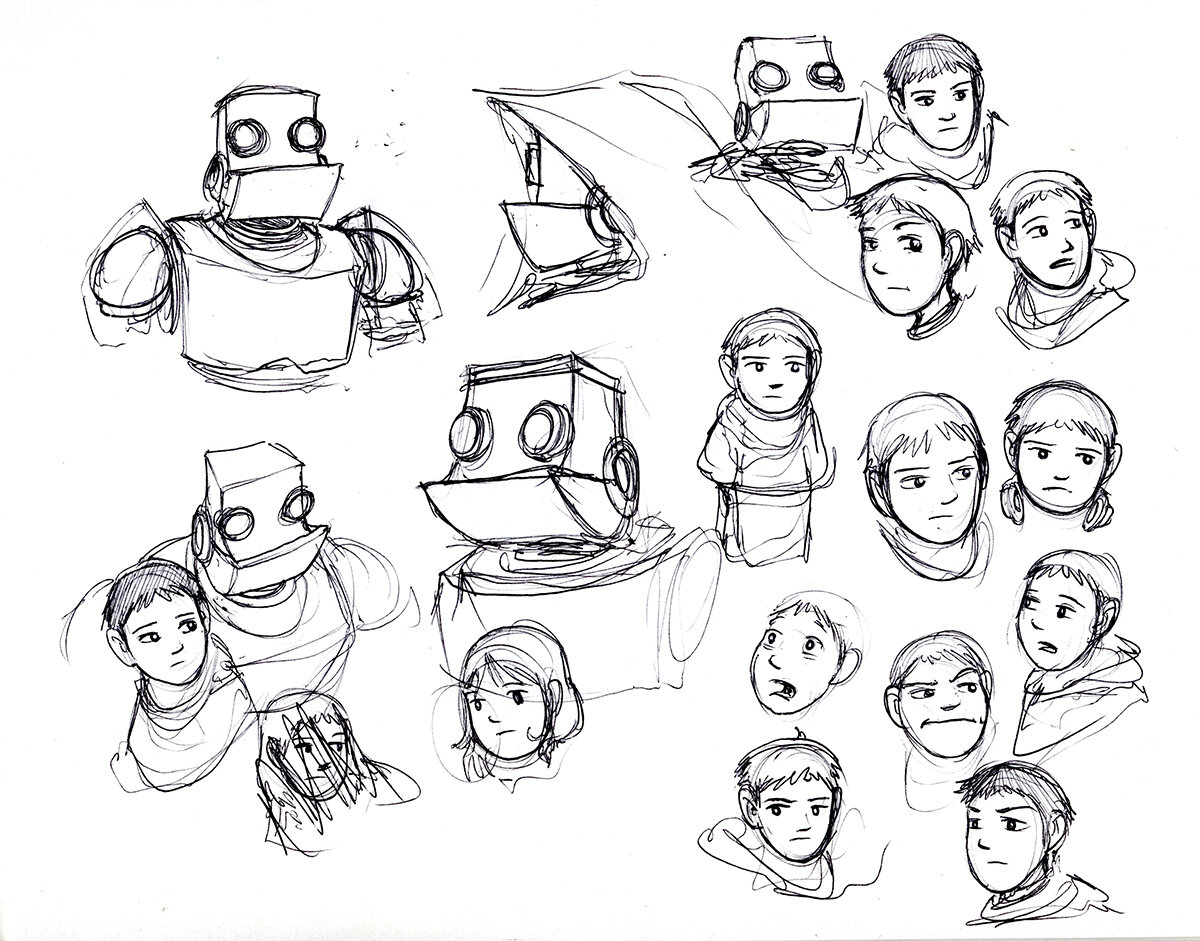The Making of Amulet
by Kazu Kibuishi
Amulet is a project I have thought about since I was 19 years old. I was a sophomore Film and Media Studies major at the University of California, Santa Barbara in 1997 when I read the graphic novel series Nausicaa of the Valley of the Wind by Hayao Miyazaki for the first time. It left me emotionally overwhelmed. Soon after, I read Bone by Jeff Smith and felt equally inspired. To me, these books represented some of the highest forms of literature- like The Lord of the Rings or The Chronicles of Narnia but with the addition of worlds and characters fully illustrated by the authors- and the stories within the pages were told in the form of comics! I immediately knew I wanted to make something like these books, so I set a goal to create a graphic novel series that could deserve to stand on the bookshelf next to the works of these masters.
The comic below represents my first attempt at writing and drawing the story. It depicts early versions of the characters Trellis (Trelly the Thief), Leon Redbeard (Leod the Cat), and a cat named Riley. At the end of this series of pages, a few panels of Emily and Navin were drawn before they go on their journey to Alledia, and Miskit is seen as a regular stuffed animal. By the end of drawing these pages, I was already burned out, I felt the results were disappointing, and the prospect of drawing thousands more pages seemed an unacceptable amount of work for a hobby project.
Making Amulet was a personal goal, not a career ambition, so I set the project aside to focus on developing job skills. Sketches and notes for Amulet slowly developed over the years while I worked as a graphic designer in architecture and later as a writer/director/3D animator for a small animation studio in Pasadena, California.
In 2003, I pitched an animated movie called Let’s Get Francis to Walt Disney Feature Animation and they optioned the rights to make it. I was brought on board as co-director and writer of the film. Having done extensive research on films with long development processes, I had a pretty good sense I was not going to get a chance to direct this movie. Already several years out of college, time was of the essence and I was looking to gain storytelling experience, so I signed away the rights to the movie and left my job in animation to focus my efforts on graphic novels.
Early efforts during this time included Daisy Kutter: The Last Train, a comic book mini-series published by Viper Comics, and the graphic novel anthology Flight, published by Image Comics (and later by Ballantine/Villard Books at Random House). They were both released to critical acclaim in 2004, while my webcomic Copper was growing in popularity online. Around this time, Scholastic sent me an email to inquire about new projects. With two published books under my belt, I decided to return to Amulet and give it another try. In 2005, I pitched Amulet to Scholastic Creative Director David Saylor and Editor Janna Morishima at Scholastic’s new Graphix Books imprint. Along with a short synopsis, I showed them the pages displayed below. Scholastic Graphix signed on to publish the first two books.
Amulet: The Stonekeeper (2008)
Creating the first Amulet book proved to be more difficult than anticipated. The book was originally scheduled for a 2006 release, but I had difficulty meeting the original deadline. The book went into multiple redrafts, which often involved discarding fully painted sequences. After three failed attempts at a successful draft, I discarded everything but a few scenes from the different drafts. New scenes were created to connect those scenes together, and this is how my process for creating graphic novels was born.
Multiple drafts of each scene are created to find the best one. Many scenes require a minimum of three drafts while some difficult scenes can take as many as twenty drafts. The best material is often created not by design, but by accident, so I schedule time to make plenty of mistakes.
The sheer volume of work on a graphic novel can necessitate collaboration. While I handled most of the coloring for Amulet 1, I did have a team of friends and interns providing support. The first team included Alan Beadle, Dawn Fujioka, Dave Au, Katy Wu, Arree Chung, Erik Martin, Sho Katayama, Kean Soo, Sarah Mensinga, Matthew Armstrong, Molly Hahn, Shadi Muklashy, Chris Appelhans, and Amy Kibuishi. It would take many years to figure out how to properly color and produce these books, so the first year was mostly a learning experience. Many mistakes were made, but this helped develop an understanding of the coloring process.
While drawing and coloring a book can be a massive amount of work, most of my time and energy creating Amulet goes into the research and writing phase of production. Making decisions about characters’ actions or what to show and what not to show a reader has always been the most difficult stage in the creation of a book. One such difficult decision was the choice to keep the opening sequence for Amulet. I started to get cold feet about including something so dark and emotionally charged to begin an all-ages publication. David Saylor instilled confidence in me that the audience could handle the scene’s intensity and asserted that the dramatic sequence should stay intact. Much of Amulet: The Stonekeeper was changed several times during its production, but the book’s opening prologue sequence has always remained the same.
Due to several unexpected redrafts of the book, the release of Amulet: The Stonekeeper was pushed back to January 2008. Unlike Flight and Daisy Kutter, Amulet was quietly released to mixed reviews and low initial sales. Despite what seemed like disappointing early returns, David Saylor and my literary agent Judith Hansen remained confident in the project, reminding me that this was just the beginning of a long process.
When I studied the history of my favorite books and movies, I discovered they often took longer than usual to be accepted by a wide audience. Remembering this, I remained committed to Amulet despite offers to create movies and television shows based on other work. Despite the slow start, the book soon found a growing audience through the recommendations of many young readers, their librarians, teachers, and parents. While Amulet did not garner the critical acclaim or awards recognition of my previous efforts, it did start to generate tremendous interest with the group I intended to reach: readers who were not only new to comics, but were new to reading books of any kind.
Early Concepts
Every story requires a lot of sketching and design work before the characters and the scenes are ready to be featured in a book. Along with the writing phase, this is a very time-consuming part of the production. Included below are some early promotional drawings that were done for the book prior to production and very early concept sketches for the story. These images give a glimpse of the early development process for Amulet.
Amulet 2: The Stonekeeper’s Curse (2009)
Production on Amulet 2: The Stonekeeper’s Curse was already underway in 2007 before the release of Amulet 1. I went into the second project making a checklist of things I wanted to do better. Goals included bringing the fantasy adventure part of the books into focus, increasing the scale of the story’s concepts, and to make this book more fun to read than the first.
The mistakes and setbacks experienced during the production of the first book provided valuable lessons learned for the creation of The Stonekeeper’s Curse. Among the many things learned were the importance of drawing quickly and setting manageable, achievable goals.
This time, I set up a smaller dedicated staff to assist with the colors. Digital painter Anthony Go Wu was hired to help color the book as a full time employee. He was soon joined by a recent college graduate named Jason Caffoe who I met during a Savannah College of Art & Design field trip, where Amy and I served as guest lecturers. Jason proved to be a very quick study, and soon he and Anthony became the first full-time employees of Bolt City Productions. I also had a new editor, Sheila Keenan, who later worked with us on the Explorer anthology.
With the knowledge and momentum gained from the difficult production of Amulet 1, we were able to complete Amulet 2 in much less time despite the book being longer and featuring more detailed artwork. The book was released in 2009 to stellar reviews and became the first Amulet book to be a New York Times Bestseller.
——————————————————————-
More Amulet history on the way. I’ll continue to update this story during breaks in production on Amulet 9.

